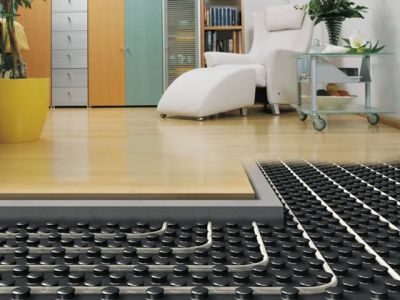
Wooden floors have become very popular in recent years, with more home owners than ever seeing the advantages of a floor that is durable, eye catching and easy to clean. And as winter’s becoming colder and more snowy each year many people often decide to install under floor heating . But apart from documented savings in energy costs, possibility of spending quality time in cosy, pleasantly warm environment (which also creates more friendly space for allergy sufferers) there are some other important factors that all floor owners should take in to account before the green light to underfloor heating installation will be given.
The very important point is that most of hardwood floors are subject to expansion and contraction, according to the amount of moisture in the immediate environment. Planks can contract slightly during winter months (when central heating produces drier atmosphere) and expand during the summer months when windows are open and the atmosphere within the house has more moisture. This seasonal movement never stops and it is quite normal property of wooden floors – regardless of the age of the wooden floor. This expansion and contraction can also be amplified when underfloor heating is taken in to account.
Another factor is that wood is a great insulator. This means that it slows down the transmission of the heat generated by the underfloor heating system. This of course reduces system’s efficiency but wood is less insulating than other flooring types such as carpet. The heat transmission property of the wood can also be beneficial in that wood holds the heat for a long time after the underfloor heating system is switched off. This means that the room will remain warmer for longer period. The floor will feel pleasantly warm but not hot underfoot.
Underfloor heating works well with wooden floors because it keeps the whole floor at a constant temperature and other heating devices such as free standing heaters and radiators can create hot areas on wooden floors which can lead to warping. Warping is the main worry of home owners with wooden floors when they are considering installing an underfloor heating system.
Underfloor heating systems have to be carefully installed, therefore such system should be designed to spread the heat equally over the entire floor and the control settings should be set up to avoid big and sudden changes in temperature. Properly designed and installed underfloor heating system should be able to prevent warping of the wooden floor.
Before installation of underfloor heating we need take in to consideration that modern engineered wood floors are more suitable than solid hardwood floors for that purpose. Engineered wood floors consist of plywood or MDF boards covered with a hardwood veneer to give an attractive appearance. They are more stable and less prone to warping than solid hardwood floors. An engineered floor can easily be taken up and refitted once the underfloor heating system has been fitted.
ESB Sales Team members will advise you about wooden floors that are suitable for underfloor heating systems. You can contact us or visit our North London Showroom if you require more information and advice.
| Mon-Fri | 8:00AM – 5:00PM |
| Saturday | 10:00AM – 4:00PM |
| Sunday | 11:00AM – 3:00PM |





.svg)
.svg)